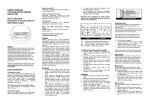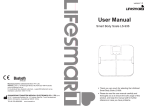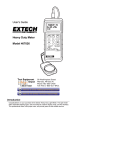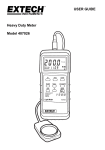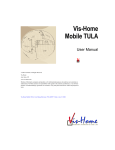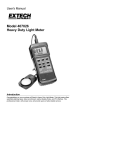Transcript
USER’S MANUAL PHOTOELECTRIC SMOKE ALARM 9 Volt Battery Operated Photoelectric Smoke Alarm Fully automatic test function Advanced electronics ensure the best possible operating readiness by means of an automatic self-test function. l l Battery warning function By means of a warning sound repeated every 43 seconds (for up to one month), the smoke detector signalises that the power supply of the battery is insufficient and it needs to be replaced. recommended to install a smoke alarm on the ceiling as well. A smoke alarm shall be installed in the sleeping area of a caravan. For complicated or extensive properties please request qualified advice from a safety engineer or the fire brigade. Regarding the installation of single smoke alarms it is distinguished between minimum and additional protection: If the smoke alarm cannot be heard after pressing the button or if the LED does not flash, please do check the following points: Control button Temporarily increases the detector’s sensitivity to test the alarm function. Noisy (85 dBA) piezoelectric warning sound Vibrant warning sound in case of fire alarm high efficiency This device does not contain any radioactive substances! General Smoke alarms sound their alarm horn when they detect smoke. Everything preventing the smoke from reaching the alarm obstructs an early alarm. A single smoke detector provides only limited security. Fire in another room will only be detected after smoke reaches the alarm. It is therefore recommended to install a smoke alarm on every level of the home if not in every room. Inform yourself about fire safety rules and proper behaviour in case of a fire at your fire brigade! Product characteristics Photoelectric effect This recently developed photoelectric sensorcamber is insensitive to interfering influences. Every device is separately calibrated in order to avoid false alarms due to, e.g., cigarette smoke. The power supply is electronically regulated, thereby maintaining a constant sensitivity of the alarm. Battery operation The functioning of the detector is maintained even in case of a power failure. On an average the battery’s (standard 9V battery) service life is 1 year. Signal lamp (LED) A flashing small light (every 43s) signalises a failure-free operation. Function Smoke caused by fire is very dangerous, especially because of today’s widespread use of synthetic materials in modern homes that might generate poisonous vapours when burning. The smoke alarm detects smoke caused by smouldering at an early stage and warns by means of a loud, vibrant sound, thereby waking inhabitants up at a point of time when a safe escape is still possible. The smoke alarm operates according to the scattered light principle. A light source and a photocell are arranged so as to ensure that normally no light strikes the photocell. The light source is activated in short intervals. If the concentration of smoke particles in the enclosure reaches a certain level, the light is reflected and reaches the photocell. This will set off a loud fire alarm. Placement l As most fires in flats start in the living areas, it is recommended to install smoke alarms between the living and sleeping areas. l As a minimum requirement a smoke alarm should be installed outside every sleeping area in a flat. If there are separate sleeping areas a smoke alarm is to be installed outside each sleeping area. l The minimum requirement for multistorey houses is to install a smoke alarm on every floor of the house and outside each sleeping area, e.g. in the hallway connecting the sleeping rooms or on the stairway leading to this hallway. If there is a room in the attic, it is strongly Testing the alarm A flashing LED signals accurate operation. A loud, vibrating sound occurs in case of a smoke alarm. A short whistling tone occurs every 30 to 40 seconds for up to one month signalling that the battery needs to be replaced. Test the smoke alarm weekly for your security by pressing the respective button (for at least 2 seconds) until you hear the alarm. DINNING ROOM BEDROOM HALL KITCHEN BEDROOM BEDROOM BEDROOM l l LIVING ROOM KITCHEN LIVING ROOM BEDROOM FINISHED BASEMENT M ULTIPLE STORY P LAN SINGLE-STORY RESIDENCE, APARTMENT MOBILE HOME HOUSE APARTMENT Required to meet BSI recommendations Recommended for additional protection Smoke Alarms with silence features recommended for additional protection The following locations shall be avoided: l Next to doors, windows, ventilators etc. where draughts can deviate smoke from the sensor. l In small or poorly ventilated garages or kitchens where waste gas or vapour may cause false alarms. l In areas where dust and dirt can interfere with the smoke alarm operation or cause false alarms. l In areas where insects are likely to trigger the alarm. l In damp or humid areas (e.g. in the bathrooms). l In rooms where the temperature may often fall below –5°C or exceed +38°C. Installation l Attach the mounting bracket to the ceiling or wall. l Install the battery (included).Match the terminals on the end of the battery with the terminals on the unit. Match “+” to “+” and “-” to “-.” Push the battery in until it snaps in securely and cannot be shaken loose. l Attach the Smoke Alarm to the mounting bracket. Turn the smoke alarm clockwise (right) until it snaps into place. l Check immediately after finishing the installation that the smoke detector works properly by pressing the test button for at least 2 seconds. l Is the device damaged? Is the device clean? (For your security please vacuum the outside cover regularly to remove dust and dirt.) Is the battery working properly? Are you using the required battery type? Is the battery connected properly? Replace the battery if necessary. If the smoke alarm is still not working, do not attempt to repair it but contact a professional. False alarms After every alarm, check if there is a fire. In case of a false alarm do not remove the battery, but fan the air around the smoke alarm until the alarm turns off (if necessary vacuum the outside cover) . After the alarm the device is immediately ready for operation. Maintenance Periodic maintenance contributes to a long service life of the smoke alarm and ensures a failure-free operation. l Clean the outside cover with a damp cloth at least every three months (do not use any detergent!). l Vacuum the outside cover and vents every three month. Never let the vacuum cleaner come in contact with the interior parts of the smoke alarm. Please note! The smoke alarm requires sufficient power to operate. l Please use the appropriate type of brand batteries (Type IEC 6 LR61, 9V). l Please check the polarity of the battery carefully. l Please verify that the smoke alarm is working properly immediately after replacing the batteries. l In case of the battery warning signal replace the battery immediately. Otherwise please change it at least once a year.
